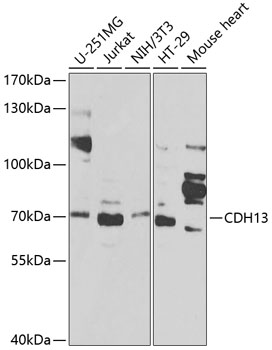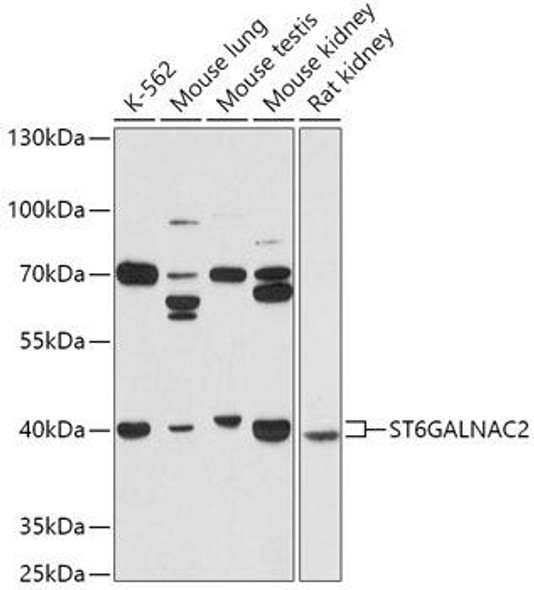Cell Biology Antibodies 7
Anti-CDH13 Antibody (CAB1761)
- SKU:
- CAB1761
- Product Type:
- Antibody
- Reactivity:
- Human
- Reactivity:
- Mouse
- Host Species:
- Rabbit
- Isotype:
- IgG
- Antibody Type:
- Polyclonal Antibody
- Research Area:
- Cell Biology
Description
| Antibody Name: | Anti-CDH13 Antibody |
| Antibody SKU: | CAB1761 |
| Antibody Size: | 20uL, 50uL, 100uL |
| Application: | WB |
| Reactivity: | Human, Mouse |
| Host Species: | Rabbit |
| Immunogen: | Recombinant fusion protein containing a sequence corresponding to amino acids 120-370 of human CDH13 (NP_001248.1). |
| Application: | WB |
| Recommended Dilution: | WB 1:500 - 1:2000 |
| Reactivity: | Human, Mouse |
| Positive Samples: | U-251MG, Jurkat, NIH/3T3, HT-29, Mouse heart |
| Immunogen: | Recombinant fusion protein containing a sequence corresponding to amino acids 120-370 of human CDH13 (NP_001248.1). |
| Purification Method: | Affinity purification |
| Storage Buffer: | Store at -20'C. Avoid freeze / thaw cycles. Buffer: PBS with 0.02% sodium azide, 50% glycerol, pH7.3. |
| Isotype: | IgG |
| Sequence: | SLQD IFKF ARTS PVPR QKRS IVVS PILI PENQ RQPF PRDV GKVV DSDR PERS KFRL TGKG VDQE PKGI FRIN ENTG SVSV TRTL DREV IAVY QLFV ETTD VNGK TLEG PVPL EVIV IDQN DNRP IFRE GPYI GHVM EGSP TGTT VMRM TAFD ADDP ATDN ALLR YNIR QQTP DKPS PNMF YIDP EKGD IVTV VSPA LLDR ETLE NPKY ELII EAQD MAGL DVGL TGTA TATI MIDD KNDH SPKF TKKE FQA |
| Gene ID: | 1012 |
| Uniprot: | P55290 |
| Cellular Location: | Cell membrane, GPI-anchor, Lipid-anchor |
| Calculated MW: | 19kDa/21kDa/73kDa/78kDa/83kDa |
| Observed MW: | 70kDa |
| Synonyms: | CDH13, CDHH, P105 |
| Background: | This gene encodes a member of the cadherin superfamily. The encoded protein is localized to the surface of the cell membrane and is anchored by a GPI moiety, rather than by a transmembrane domain. The protein lacks the cytoplasmic domain characteristic of other cadherins, and so is not thought to be a cell-cell adhesion glycoprotein. This protein acts as a negative regulator of axon growth during neural differentiation. It also protects vascular endothelial cells from apoptosis due to oxidative stress, and is associated with resistance to atherosclerosis. The gene is hypermethylated in many types of cancer. Alternative splicing results in multiple transcript variants encoding different isoforms. |
| UniProt Protein Function: | CDH13: Cadherins are calcium-dependent cell adhesion proteins. They preferentially interact with themselves in a homophilic manner in connecting cells; cadherins may thus contribute to the sorting of heterogeneous cell types. May act as a negative regulator of neural cell growth. 3 isoforms of the human protein are produced by alternative splicing. |
| UniProt Protein Details: | Protein type:Membrane protein, GPI anchor; Cell adhesion Chromosomal Location of Human Ortholog: 16q23.3 Cellular Component: extracellular space; neuron projection; focal adhesion; cytoplasm; plasma membrane; caveola; external side of plasma membrane Molecular Function:adiponectin binding; protein homodimerization activity; cadherin binding; low-density lipoprotein binding; calcium ion binding Biological Process: lamellipodium biogenesis; intercellular junction assembly and maintenance; positive regulation of positive chemotaxis; positive regulation of smooth muscle cell proliferation; Rac protein signal transduction; positive regulation of calcium-mediated signaling; negative regulation of cell adhesion; keratinocyte proliferation; Rho protein signal transduction; regulation of epidermal growth factor receptor signaling pathway; low density lipoprotein mediated signaling; negative regulation of cell proliferation; localization within membrane; calcium-dependent cell-cell adhesion; regulation of endocytosis; endothelial cell migration; positive regulation of transcription from RNA polymerase II promoter; positive regulation of endothelial cell proliferation; sprouting angiogenesis; positive regulation of cell-matrix adhesion; homophilic cell adhesion; positive regulation of cell migration |
| NCBI Summary: | This gene encodes a member of the cadherin superfamily. The encoded protein is localized to the surface of the cell membrane and is anchored by a GPI moiety, rather than by a transmembrane domain. The protein lacks the cytoplasmic domain characteristic of other cadherins, and so is not thought to be a cell-cell adhesion glycoprotein. This protein acts as a negative regulator of axon growth during neural differentiation. It also protects vascular endothelial cells from apoptosis due to oxidative stress, and is associated with resistance to atherosclerosis. The gene is hypermethylated in many types of cancer. Alternative splicing results in multiple transcript variants encoding different isoforms. [provided by RefSeq, May 2011] |
| UniProt Code: | P55290 |
| NCBI GenInfo Identifier: | 1705552 |
| NCBI Gene ID: | 1012 |
| NCBI Accession: | P55290.1 |
| UniProt Secondary Accession: | P55290,Q6GTW4, Q8TBX3, A8W476, A8W477, B7Z590, C9JRI6 J3KN62, |
| UniProt Related Accession: | P55290 |
| Molecular Weight: | 713 |
| NCBI Full Name: | Cadherin-13 |
| NCBI Synonym Full Names: | cadherin 13 |
| NCBI Official Symbol: | CDH13 |
| NCBI Official Synonym Symbols: | CDHH; P105 |
| NCBI Protein Information: | cadherin-13; T-cad; T-cadherin; heart cadherin; H-cadherin (heart); cadherin 13, H-cadherin (heart) |
| UniProt Protein Name: | Cadherin-13 |
| UniProt Synonym Protein Names: | Heart cadherin; H-cadherin; P105; Truncated cadherin; T-cad; T-cadherin |
| UniProt Gene Name: | CDH13 |
| UniProt Entry Name: | CAD13_HUMAN |







